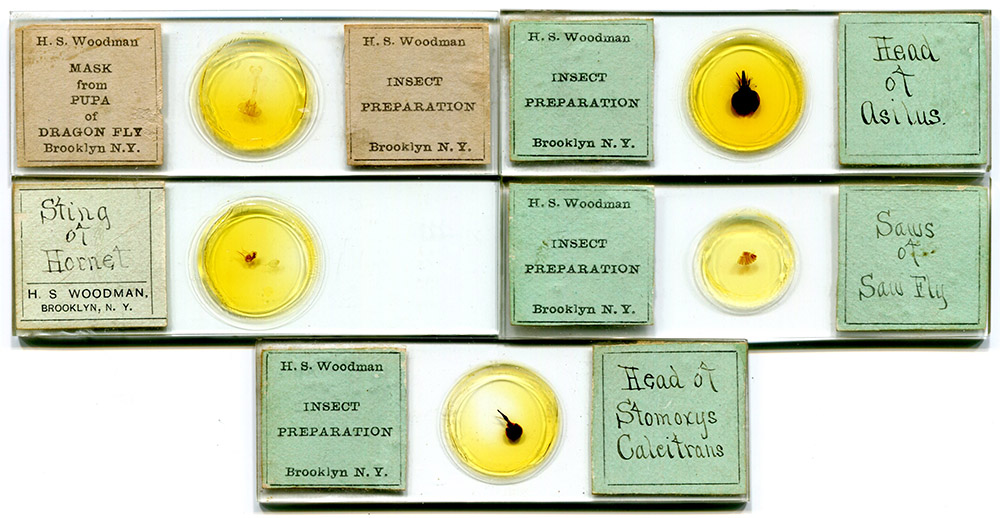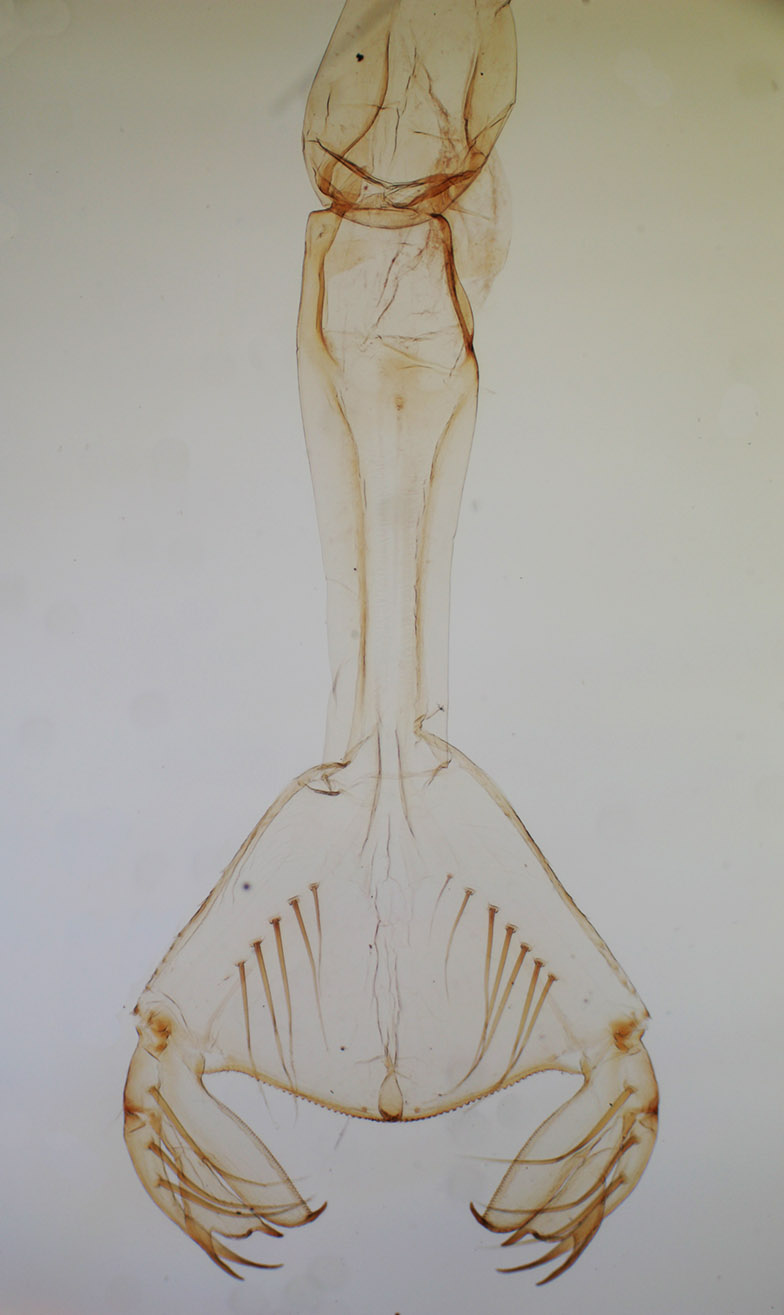Henry S. Woodman, 1845-1918
by Brian Stevenson
last updated July, 2020
Henry Woodman, of Brooklyn, New York, was a highly-regarded amateur preparer of microscope slides. He was especially interested in mounting entomological specimens.
Woodman worked as a book keeper for a hardware business, yet acquired skills to prepare and mount insect specimens by the age of 35. By 1881, he was advertising to exchange “first-class insect preparations”. By the mid-1880s, he was a member of the Brooklyn Microscopical Society, the New York Microscopical Society, and the American Postal Microscopical Club. In 1884, William Walmsley (1830-1905) wrote “A special box of insect preparations contributed to the American Postal Microscopical Club by Mr. H.S. Woodman, of Brooklyn has recently passed through our hands, and does him much credit as a skillful preparer in this line”.

Figure 1.
Microscope slides by H.S. Woodman, circa 1880-1918. Three of these specimens were included in a circulating box that Woodman prepared for the American Postal Microscopical Club in 1884: “Mask of Pupa of Dragon-Fly”, “Head of Robber Fly, Asilus”, and “Saws of Saw-Fly”.

Figure 2.
Head of a dragonfly pupa, by H.S. Woodman (see Figure 1). Photographed with a C-mounted digital SLR camera and 3.5x objective lens.

Figure 3.
Mouthparts of a dragonfly pupa, by H.S. Woodman (see Figure 1). Photographed with a C-mounted digital SLR camera and 3.5x objective lens.

Figure 4.
Sting of hornet, by H.S. Woodman (see Figure 1). Photographed with a C-mounted digital SLR camera and 3.5x objective lens.
Henry S. Woodman was born in Gorham, Maine, which is near Portland. Two official birth records are known: one issued in Gorham that gives a birth date of December 11, 1845, and a second that was issued in Portland with a stated birth date of December 25, 1845. The Gorham birth record gives Henry two middle initials, “S.H.”, while the Portland record gives only “S.”. His parents were Marshall H. and Martha (née Hamlen) Woodman, so the “H.” probably stood for “Hamlen”. I did not find any records that spelled out the “S.” middle name.
Henry’s mother died in May, 1848. He does not appear to have had any siblings. The 1850 census shows Henry living in Gorham with his widowed grandmother, Jane Woodman, while Marshall worked as a “machinist” in Portland. Henry’s father apparently died during the 1850s, as he is not found in the 1860 census, and that census states that 14 year-old Henry owned a personal estate valued $600.
Henry moved to New York City during the 1860s. The 1870 census lists him as a boarder in Brooklyn, working as a book keeper for a hardware business.
He married Sarah Jennifer Crane on October 6, 1870, in Brooklyn. They appear to have had four children, one of whom disappeared between the 1875 and 1880 censuses, and presumably died in infancy.
During 1881, Woodman published exchange offers that proclaimed his skill as a slide-maker: “Wanted - First-class mounts of double-stain vegetable preparations in exchange for first-class insect preparations. H.S. Woodman, P.O. Box 87, Brooklyn, E.D., N.Y”, and “A few well-mounted slides of, parts of insects, such as heads of flies, stings and tongues of bees, to exchange for other well-mounted objects,. H. S. Woodman, P.O. Box 87, Brooklyn, E.D., N.Y.”.
In 1884, Woodman produced the box of six entomological slides that was mentioned above. The editor of The American Monthly Microscopical Journal wrote:
“Postal Club Boxes … Box 29 is a special contribution from Mr. H.S. Woodman, of Brooklyn, N. Y. It contains specimens of insect preparations, and may be taken as a type of what a good box should be. Without doubt it is the most instructive box that has come to our circuit this season. There is a brief description given of each specimen, stating the general method of preparing or mounting it, followed by a few words indicating the special features to be observed. The objects in the box are:
1. Sting of Honey-Bee mounted in glycerin. Mr. Walmsley, says of this mount that it testifies to the efficiency of wax cells for fluid mounts first introduced by himself. He also refers to the value of the white-zinc cement, of which he speaks highly.
2. Head of Robber Fly, Asilus sp.
3. Mask of Pupa of Dragon-Fly. This is a very instructive specimen.
4. Head of Horse-Fly, Tabanus lineola. The method of preparing the specimen is given in detail.
5. Saws of Saw-Fly. In referring to the subject of mounting these specimens, the preparer states that in using the carbolic acid method" he was at first not successful, but found the reason for the unsatisfactory results was that he had been using a solution of carbolic acid in alcohol. On using an aqueous solution the results were excellent.
6. Silk Worm. This is a fine preparation which shows the tracheal system beautifully”.
Three of those specimens are shown in Figure 1, above. This group of Woodman slides was recently acquired together, as part of a large collection, and may have been obtained by the original owner as a consequence of having seen Woodman’s box of slides through the American Postal Microscopical Club. Woodman advertised his slides in other ways, too: he sent a “slide of sting of honey-bee” to the editor of The Microscope in 1889, which was then highlighted to readers.
Woodman became a member of the Executive Committee of the Brooklyn Microscopical Society during the 1880s. In 1890, he was elected to be the President. This society was the oldest component of the Brooklyn Institute of Arts and Sciences, having been established in 1880, and Woodward appears to have been one of the earliest members. He was also a member of the Brooklyn Institute’s Department of Entomology.
Among the many exhibits that Woodman presented to the Microscopical and Entomological groups were: “the reflection of the second-hand of a watch in each facet of the beetle's eye. The definition of this display was particularly fine” (1887); talks on “Rapid methods for the preparation and mounting of entomological specimens for microscopic purposes” and “Methods of mounting objects in glycerine” (both in 1890); “Circulation of protoplasm (cyclosis) in the water plant Nitella” (1894); and “Plant sections and what they teach” (1904).
The 1910 census recorded that Henry Woodman was still working as a book keeper for a hardware business. He, his wife, and their eldest daughter all lived in the same home on Van Buren Street, Brooklyn, where they had resided for several decades.
Woodman remained an active microscopist until the end of his life. He was still a member of the Executive Committee of the Brooklyn Microscopical Society in 1917.
Henry Woodman passed away on October 4, 1918, of “mitral insufficiency, artero sclerosis”.
Resources
The American Journal of Microscopy and Popular Science (1881) Exchange offer from H.S. Woodman, Vol. 6, page 208
The American Monthly Microscopical Journal (1881) Microscopical societies: New York, Vol. 2, page 79
The American Monthly Microscopical Journal (1881) Exchange offers from H.S. Woodman, Vol. 2, pages 200 and 240
The American Monthly Microscopical Journal (1884) Postal Club boxes, Vol. 5, page 75
The American Monthly Microscopical Journal (1887) Brooklyn Microscopical Society, Vol. 8, page 97
Death record of Henry S. Woodman (1918) accessed through ancestry.com
Journal of the New-York Microscopical Society (1887) Brooklyn Microscopical Society, Vol. 4, pages 96-97
Journal of the New-York Microscopical Society (1894) The Fifteenth Annual Exhibition of the Society, Vol. 10, pages 77-82
The Microscope (1889) Vol. 9, page 114
The Microscopical Bulletin (1884) Vol. 1, page 21
New York Tribune (1918) Obituary of Henry S. Woodman, October 7 issue, page 6
Scientific American (1889) The annual reception of the Department of Microscopy of the Brooklyn Institute, Vol. 62, page 307
US census and other records, accessed through ancestry.com
Year Book of the Brooklyn Institute (1890) pages 43, 58, 132-133, and 140
Year Book of the Brooklyn Institute (1904) pages 192-194
Year Book of the Brooklyn Institute (1917) page 102



